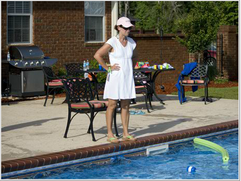Designate a water watcher when you are in, on, or around water.
Watch all children and adolescents swimming or playing in or around water, even if they know how to swim.
Young children or inexperienced swimmers need to be within arm’s reach of an adult at all times.
Make sure a responsible person constantly watches young children in the bath.
An Appropriate Water Watcher
|
Here's Why
- Drowning is the second leading cause of unintentional injury deaths for children 1-14 years of age.
- Three children die every day as a result of drowning.
- Drowning kills more children 1-4 than anything else except birth defects.
- Most fatal drownings happen when there is poor or absent supervision.
- Drowning can happen quickly and quietly.
- Drowning can happen even in the presence of lifeguards.
More Information
- A water watcher is not a substitute for a lifeguard. Choose a lifeguard protected area if possible, and designate a water watcher.
- Prevention is the key role of a water watcher. Don’t wait for an emergency. Encourage safe activities and stop any unsafe or risky behaviors.
- For any child who is a non-swimmer or lacks water competency skills, the water watcher should provide “touch supervision”, be close enough to reach the child at all times to grab the child.
- Because drowning can be quick and quiet, the water watcher should pay constant attention, be undistracted, not be involved in any other activity (such as reading, playing cards, talking on the phone, or mowing the lawn) while supervising children, even if lifeguards are present.
- Parents, caregivers, aquatic facility owners, managers and operators should use multiple “layers of protection” to ensure safety. Layers of protection include ensuring that:
> unintended access to pools or other bodies of water is prevented by fencing or other barriers;
> U.S. Coast Guard approved lifejackets are used to aid inexperienced swimmers;
> all swimmers are closely, attentively, continuously, and redundantly supervised by water watchers and/or lifeguards;
> persons with the knowledge, skills and ability to safely effect a water rescue and initiate CPR are on site; and,
> emergency services can be alerted if needed (access to 911).
Resources
- Online home pool rescue and operations training: American Red Cross and National Swimming Pool Foundation
- American Red Cross Circle of Drowning Prevention
- Seattle Children’s Hospital
- Keeping Kids Safe In And Around Water: Exploring Misconceptions That Lead To Drowning: Safe Kids Worldwide
Media Advisory on Proper Terminology
Drowning is not always a fatal event. Some people die as a result of drowning, while others survive with serious, life-long injuries, or none at all. Thus, the term “drowning” should not be used to imply death. According to the World Health Organization: “Drowning is the process of experiencing respiratory impairment from submersion/immersion in liquid. Drowning outcomes are classified as death, morbidity and no morbidity. Agreed terminology is essential to describe the problem and to allow effective comparisons of drowning trends. Thus, this definition of drowning adopted by the 2002 World Congress on Drowning should be widely used.”
About the Authors of this Document: Water Safety USA
Water Safety USA is a consortium of leading national governmental and nongovernmental organizations with a strong record of providing drowning prevention and water safety programs. Our mission is to empower people with resources, information, and tools to safely enjoy and benefit from our nation's aquatic environments. Our membership is as follows:
American Academy of Pediatrics
American Red Cross
Boy Scouts of America
Centers for Disease Control and Prevention
National Park Service
National Safe Boating Council
National Swimming Pool Foundation
Safe Kids Worldwide
U.S. Army Corps of Engineers
U.S. Coast Guard
U.S. Consumer Product Safety Commission
United States Lifesaving Association
USA Swimming Foundation
YMCA of the USA
American Academy of Pediatrics
American Red Cross
Boy Scouts of America
Centers for Disease Control and Prevention
National Park Service
National Safe Boating Council
National Swimming Pool Foundation
Safe Kids Worldwide
U.S. Army Corps of Engineers
U.S. Coast Guard
U.S. Consumer Product Safety Commission
United States Lifesaving Association
USA Swimming Foundation
YMCA of the USA

